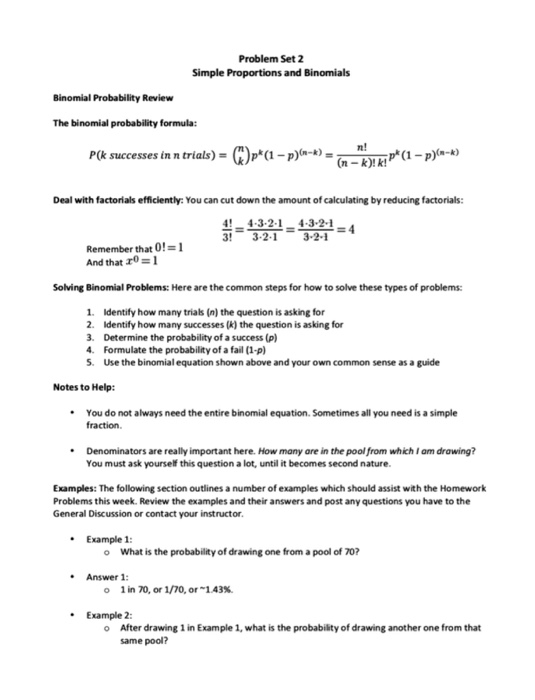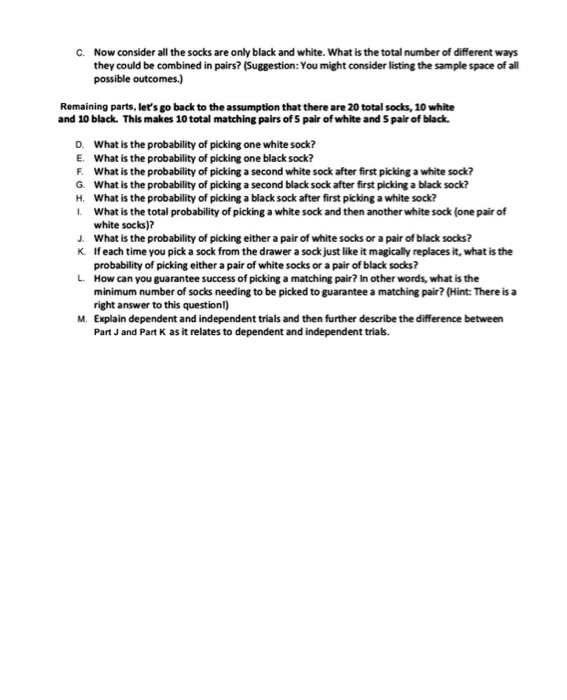Question is on 2nd and 3rd page from part A to part M.

Problem Set 2 Simple Proportions and Binomials Binomial Probability Review The binomial probability formula: PCk successes in n trials)-(e)p"(1-p)(n-k) = (n-k)! k! pk Deal with factorials efficiently: You can cut down the amount of calculating by reducing factorials 4.3-2-1 4-3-2-1 3! 3-21 3-2-1 Remember that 0!-1 And that 10 = 1 Solving Binomial Problems: Here are the common steps for how to solve these types of problems 1. 2. 3. 4. 5. Identify how many trials (n) the question is asking for Identify how many successes (k) the question is asking for Determine the probability of a success (p) Formulate the probability of a fail (1-p) Use the binomial equation shown above and your own common sense as a guide Notes to Help: You do not always need the entire binomial equation. Sometimes all you need is a simple fraction. Denominators are really important here. How many are in the pool from which I am drawing? You must ask yourself this question a lot, until it becomes second nature. Examples: The following section outlines a number of examples which should assist with the Homework Problems this week. Review the examples and their answers and post any questions you have to the General Discussion or contact your instructor * Example 1 o What is the probability of drawing one from a pool of 70? Answer 1: ln 70, or 1/70, or ~1 43%. * Example 2: o After drawing 1 in Example 1, what is the probability of drawing another one from that same pool? . Answer 2 o 1 in 69, or 1/69, or"1.44%. This is because you had just taken one out, earlier Example 3: o Solve this binomial: P(3 successes in 15 trials) with p(success)-0.5 Answer 3: o This is the 15 choose 3 binomial with ps.5 which is ~1.4% (E)pI-p)-*-(3)030(0.50)5- -o)- 455(0,125)(0.004)-0.014 e Example 4: o How many different pairwise combinations are there of 27 things? Answer This is just the (27 choose 2) part of the binomial equation. It does not use any p values so there is no need to include those o o If you have 27 things, you can pair them up 351 different ways 27 26-27 22-2)2122 13.27 351 Problems: Situation: It is a cold, dark, and stormy winter morning. Your boss has called a 5 a.m. meeting before she leaves to catch a flight to the Bahamas for her vacation, and there is a power outage. Your alarm does not go off and you sit up in bed with a fright at what you guess is about 4:45 a.m. You are trying frantically to get dressed and you need to reach into your sock drawer to get two matching socks in the dark. Naturally, your mind wanders to solving probability equations. Your sock drawer contains 20 total socks which consist of 10 matched pairs of socks. All of them are only black or white and they are loose, disorganized randomly, and not bound together. This means you have 10 black socks and 10 white socks in your disorganized drawer. You do not have a light source because your phone did not charge and you cannot find a flashlight or a candle. You are completely in the dark! You have to get dressed and gol You have to math fast Think for a minute and describe your optimal strategy for solving this problem in 50 words or less. Let's say for a moment that all 20 socks are different colors meaning that none match. What is the total number of different ways they could be combined in pairs? A B. Now consider all the socks are only black and white. What is the total number of different ways they could be combined in pairs? (Suggestion: You might consider listing the sample space of all C. Remaining parts, let's go back to the assumption that there are 20 total socks, 10 white and 10 black. This makes 10 total matching pairs of5 pair of white and S pair of black D. E. F. G. H. I What is the probability of picking one white sock? What is the probability of picking one black sock? What is the probability of picking a second white sock after first picking a white sock? What is the probability of picking a second black sock after first picking a black sock? What is the probability of picking a black sock after first picking a white sock? What is the total probability of picking a white sock and then another white sock (one pair of white socks)? J. What is the probability of picking either a pair of white socks or a pair of black socks? K. If each time you pick a sock from the drawer a sock just like it magically replaces it, what is the probability of picking either a pair of white socks or a pair of black socks? How can you guarantee success of picking a matching pair? In other words, what is the minimum number of socks needing to be picked to guarantee a matching pair? (Hint: There is a right answer to this question!) L. M. Explain dependent and independent trials and then further describe the difference between Part J and Part K as it relates to dependent and independent trials










